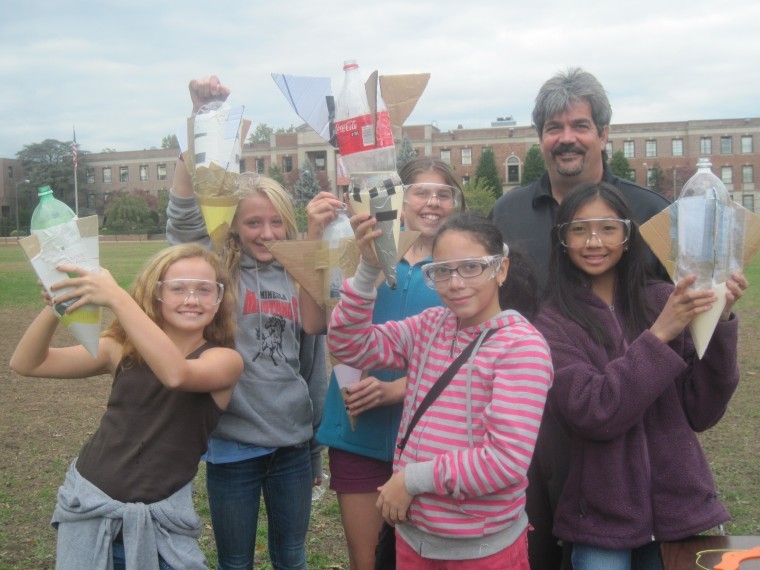The field behind the Mineola Middle School became a launching pad last Friday afternoon, as more than 40 sixth grade rocket scientists cheered on the flights of bottle rockets they’d designed on their netbooks with information culled from the Internet.
Wearing protective glasses at a discreet distance from the launch site, they lined up to observe the results of their designs as their teacher, Vincent Interrante, pumped up the pressure on the water in the rockets. The mutually supportive young rocketeers enthusiastically joined in the countdown with one voice for each launch under windy conditions that didn’t much seem to affect the flight of their prototypes.
They experienced that “Eureka” moment as each rocket – made from two-liter plastic bottles with fins and cones affixed in different configurations – flew skyward.
“That was so cool,” Ava Collica said after her rocket soared straight up with a flight duration of 4.35 seconds, one of the best times recorded on the day. “I thought it was cool how a bottle rocket with a cone and the fins went so high in the air.”
In a process similar to her fellow rocket designers, Collica had looked at bottle rocket designs online and executed her own model on her netbook. She decided 900 milliliters of water was the maximum amount of propellant to use, figuring more water would make the rocket too heavy.
How did it feel to be a rocket scientist?
“It feels awesome,” she said.
As Interrante intended when he came up with the project at a Microsoft Partners in Learning Conference last summer, the students will share their data and the results of their respective designs with students in the United Kingdom, Australia, Texas and Washington in the next phase of their work.
It was evident in conversations with the students that they had thoughtfully prepared the three-fin and four-fin rockets that had varying sizes of nose cones to make them aeronautically efficient.
Mike Demelas, whose rocket stayed aloft for 4.81 seconds, was pleasantly surprised at that result, remarking, “It went higher than I thought it would.”
Demelas said the number of fins wasn’t the crucial issue.
“It matters where you put the wings,” he said, explaining that balanced positioning was the key to success.
But Julia Gaimaro reasoned that four fins would make the rocket too heavy, so she came up with the idea of using two small fins and one large central fin to make the rocket more stable. The result was the day’s top flight time of 6.07 seconds, nearly 1.5 seconds longer than the next top rocket.
“I didn’t expect it to do this,” she said, smiling broadly. “My favorite subject is science. When I found out we were doing this, I was really excited.”
Some rockets didn’t fly straight at all. Some careened in a short arc off the launch pad. Others tumbled end over end, suggesting the need to go back to their drawing boards – in this case, the netbooks the sixth graders are using for the first time this year.
And that’s the point of the exercise, according to Interrante, who said the students will now share their results with other student designers in other states and other countries, and in turn, review the results of those students’ bottle rocket launches during the ensuring week. After obtaining their fellow rocketeers’ input, they’ll redesign their rockets for a second launch date in early November.
The whole thing runs rather like a NASA project – and the students used online rocket simulator programs in a project intended for them to learn about assimilating data, sharing it and producing a practical scientific experiment in the process.
“We initiated a project that involved 21st Century learning skills and the use of information and communication technologies,” Interrante said. “They designed the prototype and tested the prototype. They did a lot of research.”
Now as they reconsider their own rocket prototypes, they’ll act as consultants for their far-flung compatriots.
“They‘re working as rocket design experts in helping to improve the designs from other kids around the world,” Interrante said.
The enthusiasm of the students in rooting on their classmates was infectious, and Interrante said he’s pleased with the result.
“I’m thrilled. The collaboration of the students, the creativity that is involved in with the designs and the critical thinking in the design of their rockets is apparent in their work,” he said.
The sixth graders will be using their netbooks for several other projects this year, according to Interrante, who is planning other projects for them to work with students in Africa, Europe and Asia.
Reach reporter Richard Tedesco by e-mail at rtedesco@theislandnow.com or by phone at 516.307.1045 x204



